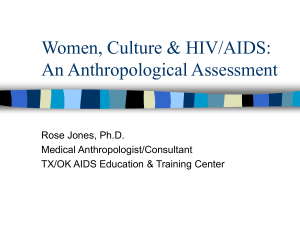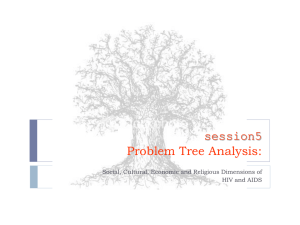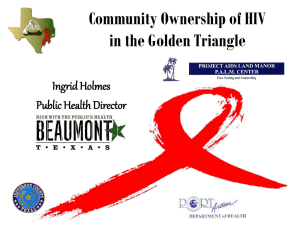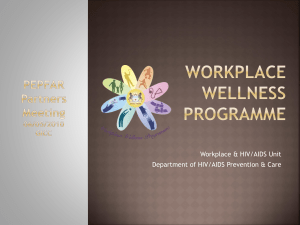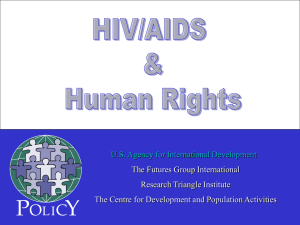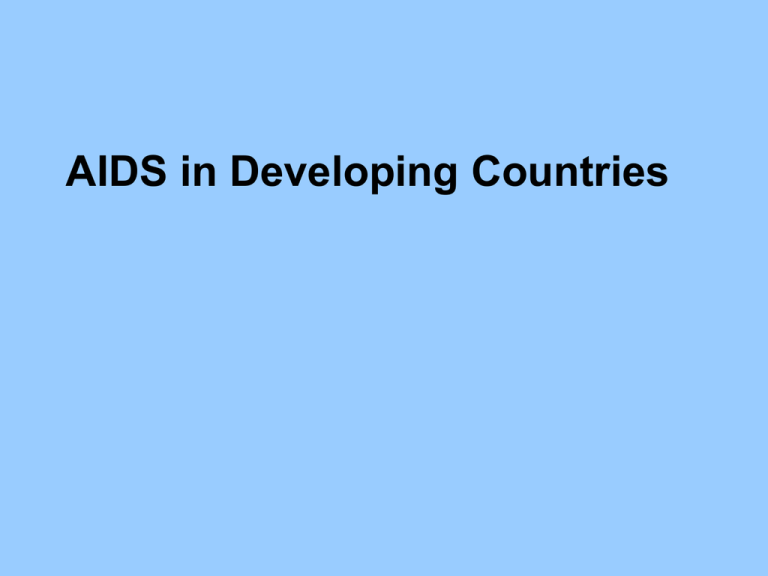
AIDS in Developing Countries
MODES OF TRANSMISSION
• Blood
• Semen/genital secretions
• Vertical
RISK ACTIVITIES THAT PROMOTE
TRANSMISSION OF HIV
• Receiving blood contaminated with HIV
• Being born to an HIV-infected mother
• Engaging in anal intercourse with an HIV-infected
partner
• Engaging in vaginal intercourse with an HIV-infected
partner
• Engaging in oral-genital intercourse with an HIVinfected partner
• Sharing needles with an HIV-infected individual
• Being exposed to HIV-infected material; e.g., health
or laboratory worker
RISK GROUPS
•
•
•
•
•
•
•
Homosexual/bisexual
Intravenous drug users
Promiscuous heterosexuals
Blood product and organ recipients
Children of infected individuals
Health/laboratory workers
Partners of HIV-infected individuals
Cohen MS: HIV prevention: rethinking the risk of transmission. Intl AIDS Vaccine Res
8(3):2, September-November, 2004.
Cohen MS: HIV prevention: rethinking the risk of transmission. Intl AIDS Vaccine Res
8(3):3, September-November, 2004.
Spread of HIV in Africa, 1990-2009
http://data.unaids.org/pub/GlobalReport/2010
Spread
of HIV in
Central
and
South
America,
19902009
http://data.unaids.org/pub/GlobalReport/2010
Spread of HIV in eastern Europe and
central Asia, 1990-2009
http://data.unaids.org/pub/GlobalReport/2010
Spread of HIV in Asia, 1990-2009
http://data.unaids.org/pub/GlobalReport/2010
http://www.aidsdatahub.org
Source: Sentinel surveillance surveys and IBBS
Source: Sentinel surveillance surveys and IBBS
http://www.aidsdatahub.org
http://www.aidsdatahub.org
Source: Sentinel surveillance surveys and IBBS
http://www.aidsdatahub.org
Source: Sentinel surveillance surveys and IBBS
Asia
(East, Southeast, and South)
•Number HIV+:4.9 million (4.5-5.5 million)
•Incidence stable: Most countries
•Incidence rising: Philippines
•
Bangladesh
•
Pakistan
http://www.usaid.gov/our_work/global_health/aids/Countries/asia/southeastasia_profile.pdf
Cambodia (2009)
•Prevalence:
0.6%
•Risk groups:
•MSM
•Non-brothel sex workers
•Mother-to-child (1/3 of total)
http://www.usaid.gov/our_work/global_health/aids/Countries/asia/southeastasia_profile.pdf
India
Prevalence of HIV:
0.3% (2.31 million) – 39% of total are females
Risk groups:
Injection drug users (northeast, Tamil Nadu)
Sex workers (south and west)
Truck drivers
Migrant workers
MSM
Monogamous wives
http://www.avert.org/aids-asia.htm
Indonesia
(2009)
•Number HIV+: 314,000 (<0.2%)
•Risk groups:
Injection drug users
Sex workers (male & female)
MSM (prevalence 5%)
http://www.usaid.gov/our_work/global_health/aids/Countries/asia/southeastasia_profile.pdf
Malaysia
• HIV/AIDS prevalence:
0.6%
• Percent who are women:
20% (2006)
• Risk groups:
Injection drug users (majority)
Sex workers (male & female)
The Philippines
• Number HIV+
8,700 (<0.47% 20072009)
• Risk groups
Sex workers
MSM
Injection drug users
http://www.usaid.gov/our_work/global_health/aids/Countries/asia/southeastasia_profile.pdf
Timor-Leste
•HIV/AIDS prevalence: 0.2%
• Risk groups:
Sex workers (3% HIV prevalence)
Men who have sex
with men (1% HIV
prevalence)
http://www.usaid.gov/our_work/global_health/aids/Countries/asia/southeastasia_profile.pdf
SW=sex worker; MSM=men who have sex with men; IDU=intravenous drug users
http://siteresources.worldbank.org/SOUTHASIAEXT/Resources/
Publications/448813-1231439344179/57261361235147661091/part1hivaidsfeb2009.pdf
HIV Testing Strategies
Blood:
1. Resistance to invasive procedures
2. Problems of processing and transport
3. Tests
•
•
•
•
ELISA
Electrophoretic techniques - the Western
blot
Rapid testing
Viral load – PCR; p24 antigen
HIV Testing Strategies
Urine testing:
1.
2.
3.
4.
5.
6.
Non-infectious material
Non-invasive
Difficulty of collecting
Preservation of urine
Ease of transport
Problem of assuring source of
specimen
7. Reasonable sensitivity and specificity
HIV Testing Strategies
Saliva testing:
1.
2.
3.
4.
5.
6.
Non-infectious material
Non-invasive
Easily collected
Ease of transport
Good sensitivity and specificity
Rapid tests
HIV Testing Strategies
Pooling:
1. For screening/surveillance, not counseling
2. Cost-effectiveness decreases with
increasing prevalence
Viral Testing
•Culture
–Expensive
–Technically demanding
•Virus particles
Polymerase chain reaction (amplifies virus)
Expensive
Requires sophisticated technology
• p24 antigen
Less accurate
Lymphocyte counts
• CD3, CD4, CD8, etc.
– Flow cytometry
– FACS analysis
– Requires sophisticated technology
– Expensive
Alternate Testing
• Total lymphocyte counts
– Inexpensive
– Simple technology
– CD4:CD8 equilibrium results in changing
relationship of subsets
– CD4/TLC curves not parallel
– Low sensitivity
• p24 acid-dissociated Ag
– Low sensitivity
– Low cost
– Low technology
• Serologic tests for T-cells (e.g., Dynabeads)
Testing Strategies
•
•
•
•
Voluntary counseling and testing (opt-in)
Routine testing (opt-out)
Mobile testing
Home testing
–Mail-in/phone for results
–Rapid test –self read in 1—20 minutes
• Confirmatory testing
FACTORS AFFECTING SPREAD OF HIV-1
BIOLOGIC
• Co-prevalence of other STDs
• Circumcision status
• Stage of HIV infection
• Viral load
• Treatment availability access and cost
FACTORS AFFECTING SPREAD OF HIV-1
BEHAVIORAL
•
•
•
•
•
•
•
Roles of males and females
Cultural acceptance of multiple partners
Types of intercourse (vaginal, anal)
Customs involving penetration of skin
Concurrency of multiple sex partners (sexual
mixing)
Condom use
Drug use (injection and non-injection)
FACTORS AFFECTING SPREAD OF HIV-1
POLITICAL/ECONOMIC
•
•
•
•
•
•
•
•
•
Political commitment
Attitudes toward risk groups
Legal status of risk groups
Attitudes toward specific sex education
Acceptability and ease of access to testing
Status of women
Level of stigma
Poverty
Availability and access to testing and
treatment
FACTORS AFFECTING SPREAD OF HIV-1
DEMOGRAPHIC
• High proportion of 15-25-year-olds
• High male:female ratio
• Rapid urbanization
• Use of trucks for transport of goods
• Large migrant population – rural to urban
• Proportion of circumcized males
Impact of the HIV/AIDS Epidemic
in Developing Countries
Alteration of the Producer:Dependent Ratio
• Decreased productivity due to illness
• Removal of producers by death
• Increased number of dependents:
– Sick babies
– Increased number of orphans
Impact of the HIV/AIDS Epidemic
in Developing Countries
Increased Health Care Costs
• Diversion of funds from other urgent
health problems
• Issues and costs of care and
hospitalization
• Need for trained health providers
Impact of the HIV/AIDS Epidemic
On the Individual
• Uncertain future
• Contemplating painful death
• Stigmatization and social isolation
• Loss of employment
• Limited access to health care
• Loss of self-esteem
Impact of the HIV/AIDS Epidemic
On the Family
• Potential infection of spouse and children
• Loss of economic support of family
• Ostracism and social isolation
• Children become orphans
Impact of the HIV/AIDS Epidemic
On Society
• Loss of productive segment of society
• Increased number of dependents
• Breakdown of family structure
• Sense of fear and distrust
• Huge burden of long-term treatment of HIV
patients
Impact of the HIV/AIDS Epidemic
in Developing Countries
Political impact
• Political instability
• Increased dependency on rich nations
BARRIERS AGAINST HIV/AIDS CONTROL (1)
•
•
•
•
•
Status of women
Low condom acceptance (esp. non-commercial sex)
Dependence on external support
Long-term sustainability of external support
Low awareness/acceptance of vulnerability
(women/youth)
• Low acceptance of testing (misguided emphasis on
“opt-in” and individual rights)
• Insufficient funds for prevention/intervention
• Stigma (risk groups, HIV-infected, those seeking
testing)
BARRIERS AGAINST HIV/AIDS CONTROL (2)
•
•
•
•
•
•
•
•
•
High proportion of uncircumcised men
Cost and complexity of adult circumcision
Low acceptance of circumcision
Low literacy rates
Few female-controlled prevention strategies (e.g.
microbicides)
Vaccine unlikely in the near future
Cost of control and treatment
Reaching unknown HIV-infected persons
Continuum of care
International Support of HIV/AIDS
Treatment (Gates, Clinton, PEPFAR, etc.)
• Buys needed drugs
• Need for infrastructure
–Source? Existing health personnel
–Undermining public health infrastructure or separate
infrastructure
• Distribution
• Adherence and counseling
• Long-term problems
–Lets local governments “off the hook”
–Sustainability
–NGOs lose interest
–Capacity of government to absorb
Current HIV/AIDS Problems in
Developing Countries (1)
Need for more widespread testing
Testing of hidden HIV+ individuals
Human rights – who are you protecting?
Continuum of care
Hidden populations (e.g., married MSM)
Persisting stigma
Current HIV/AIDS Problems in
Developing Countries (2)
Treatment
Cost of drugs
Monitoring clinical course
Assuring adherence
Reaching rural areas
Impact of huge HIV/AIDS-directed funds on:
•
•
Public health programs
Government responsibility
Sustainability – what happens when donors lose
interest?
Percentage of persons with HIV engaged in select states of the continuum of
care in the United States, by race/ethnicity
Current HIV/AIDS Problems in
Developing Countries (3)
• Treatment as prevention
• Maintaining effort and funding
• Implementing and funding for prophylactic
treatment of vulnerable populations
• Reaching unknown HIV-infected persons
• Continuum of care
SUMMARY
Despite progress made in many countries
and the declining trend of new HIV infections,
AIDS is still a leading cause of morbidity and
death among adults
Early successes in controlling HIV epidemics
may not be sustainable in the future if
continued commitment to care and prevention
is not secured


